The water underfloor heating thermostat market is expected to grow from USD 614.4 million in 2025 to USD 1,508.8 million by 2035, representing more than doubling in size, demonstrating the accelerating adoption of smart home technologies and energy-efficient heating solutions across residential and commercial sectors.
The first half of the decade (2025-2030) will witness the market climbing from USD 614.4 million to approximately USD 962.8 million, adding USD 348.4 million in value, which constitutes 39% of the total forecast growth period. This phase will be characterized by rapid consumer adoption of intelligent thermostat systems, driven by increasing energy costs and government incentives for home automation upgrades. Smart home integration capabilities and wireless control features will become standard expectations rather than premium options.
The latter half (2030-2035) will witness explosive growth from USD 962.8 million to USD 1,508.8 million, representing an addition of USD 546.0 million or 61% of the decade's expansion. This period will be defined by mass market penetration of AI-powered learning algorithms, predictive maintenance capabilities, and seamless integration with renewable energy systems. The market trajectory signals fundamental shifts in how residential and commercial properties approach thermal management, with participants positioned to benefit from sustained demand across multiple application segments.
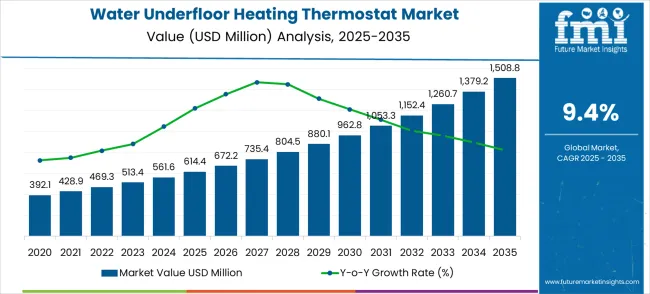
The water underfloor heating thermostat market demonstrates distinct growth phases with varying market characteristics and competitive dynamics. Between 2025 and 2030, the market progresses through its technology adoption phase, expanding from USD 614.4 million to USD 962.8 million with steady annual increments averaging 57% growth. This period showcases the transition from traditional programmable units to intelligent systems with wireless connectivity and smartphone integration becoming mainstream features.
The 2025-2030 phase adds USD 348.4 million to market value, representing 39% of total decade expansion. Market maturation factors include standardization of wireless protocols, declining component costs for smart sensors, and increasing consumer awareness of energy savings potential reaching 20-26% through intelligent temperature control. Competitive landscape evolution during this period features established HVAC companies like Danfoss and Siemens expanding their smart product portfolios while new entrants focus on app-based control interfaces and IoT connectivity.
From 2030 to 2035, market dynamics shift toward advanced integration and AI-driven optimization, with growth accelerating from USD 962.8 million to USD 1,508.8 million, adding USD 546.0 million or 61% of total expansion. This phase transition logic centers on predictive analytics, machine learning capabilities, and integration with smart home ecosystems, becoming standard rather than premium features. The competitive environment matures with focus shifting from basic connectivity to advanced energy management, occupancy detection, and integration with renewable energy systems and heat pump technologies.
| Metric | Value |
|---|---|
| $ Market Value (2025) → | USD 614.4 million |
| $ Market Forecast (2035) ↑ | USD 1,508.8 million |
| # Growth Rate ★ | 9.4% CAGR |
| Leading Technology → | Intelligent Thermostats |
| Primary Application → | Home Use Segment |
The market demonstrates strong fundamentals with intelligent thermostats capturing a dominant share through advanced learning capabilities and energy optimization features. Home use applications drive primary demand, supported by increasing consumer preference for comfort automation and energy cost reduction. Geographic expansion remains concentrated in developed markets with established smart home infrastructure, while emerging economies show accelerating adoption rates driven by urbanization and rising disposable incomes.
Market expansion rests on three fundamental shifts driving adoption across residential and commercial sectors. 1. Energy cost optimization creates compelling return on investment through intelligent temperature control that reduces heating expenses by 20-26% annually, with smart systems learning occupancy patterns and adjusting heating schedules to minimize waste during unoccupied periods. 2. Smart home integration demand accelerates as consumers seek seamless connectivity between heating controls and broader home automation ecosystems, enabling voice control, mobile app management, and integration with security and lighting systems. 3. Regulatory compliance drivers emerge from government energy efficiency mandates and building codes that increasingly require programmable or intelligent heating controls in new construction and major renovations.
The growth faces headwinds from high initial installation costs that can deter price-sensitive consumers, particularly in retrofitting existing underfloor heating systems, where additional wiring and sensor installation may be required. Technical complexity barriers also persist among older demographics who prefer simple manual controls over app-based interfaces and wireless connectivity features.
The water underfloor heating thermostat market is expanding due to growing adoption of energy-efficient home heating solutions. Programmable thermostats dominate the thermostat type segment with approximately 45% of the market share, offering precise temperature control, customizable schedules, and energy-saving capabilities that reduce consumption by 10–20%. In terms of application, home use leads with about 80% of the market, reflecting widespread adoption in residential buildings for comfort, efficiency, and automation. Market growth is driven by the increasing preference for smart home solutions, government incentives for energy-efficient heating, and rising consumer awareness of indoor climate management.
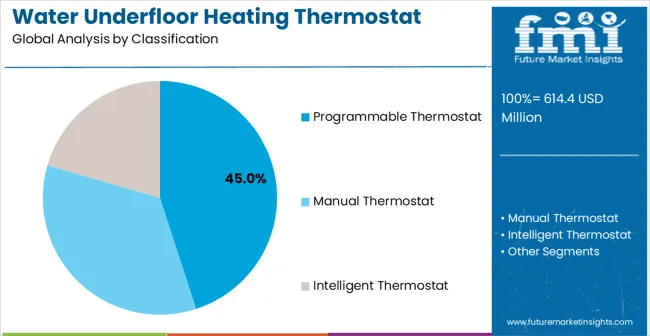
Programmable thermostats hold roughly 45% of the thermostat type segment, making them the most adopted option. These devices enable temperature scheduling, remote control via smartphone apps, and integration with smart home systems. Leading manufacturers include Honeywell, Danfoss, Siemens, and Schneider Electric. Programmable thermostats optimize energy consumption, maintain consistent indoor temperatures, and provide feedback on heating system performance. Their flexibility and automation features make them ideal for homeowners seeking efficient and convenient climate control solutions.
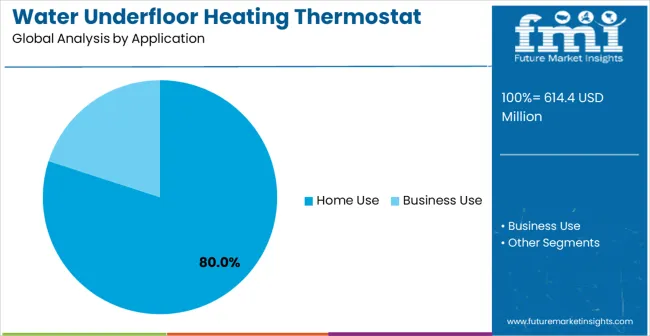
Home use applications account for approximately 80% of the market, representing the largest segment for water underfloor heating thermostats. Residential installations prioritize comfort, energy efficiency, and automated scheduling for bedrooms, living rooms, and bathrooms. Suppliers such as Honeywell, Danfoss, Siemens, and Schneider Electric provide thermostats with user-friendly interfaces, compatibility with various heating systems, and reliable temperature regulation. Segment growth is fueled by rising residential construction, adoption of smart heating solutions, and consumer preference for convenient and energy-efficient climate management.
Growth Accelerators: Energy cost reduction drives primary adoption as intelligent thermostats deliver 20-26% heating savings through occupancy-based temperature control and predictive scheduling that eliminates heating of unoccupied spaces. Smart home integration demand accelerates market expansion as consumers seek unified control platforms that manage heating, lighting, and security systems through a single mobile application with voice control capabilities. Government energy efficiency regulations and building codes increasingly mandate programmable or intelligent heating controls in new construction, creating sustained demand across residential and commercial sectors.
Growth Inhibitors: High upfront installation costs deter adoption among price-sensitive consumers, particularly in retrofit applications where additional wiring, sensors, and professional installation may be required beyond the thermostat unit cost. Technical complexity barriers persist among demographic segments preferring simple manual controls over smartphone apps and wireless connectivity features that require ongoing software updates and network maintenance. Market fragmentation across multiple wireless communication protocols creates compatibility concerns between thermostat brands and existing smart home systems, potentially limiting consumer choice and increasing installation complexity.
Market Evolution Patterns: Adoption accelerates in premium residential segments and commercial buildings where energy management justifies higher system costs, with geographic concentration in developed markets transitioning toward mainstream adoption in emerging economies driven by urbanization and disposable income growth. Technology development focuses on AI-powered learning algorithms, predictive maintenance alerts, and integration with renewable energy systems, including solar thermal and heat pump technologies that optimize overall home energy efficiency. The market thesis could face disruption if alternative heating technologies or radical improvements in building insulation reduce the economic benefits of intelligent temperature control systems.
The Water Underfloor Heating Thermostat market demonstrates varied regional dynamics with Growth Leaders including China (12.7% CAGR) and India (11.8% CAGR) driving expansion through rapid residential construction and smart home adoption. Steady Performers encompass Germany (10.8% CAGR), Brazil (9.9% CAGR), and the USA (8.9% CAGR), benefiting from established underfloor heating infrastructure and energy efficiency regulations. Emerging Markets feature the UK (8.0% CAGR) and Japan (7.1% CAGR), where retrofit installations and premium residential segments support consistent growth patterns.
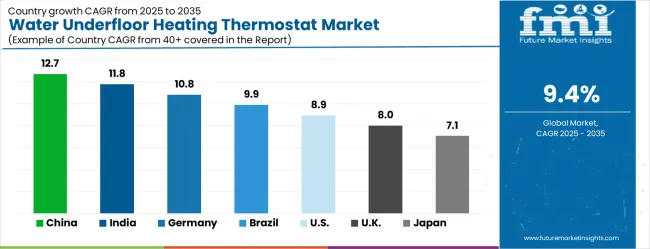
| Country | CAGR (2025-2035) |
|---|---|
| China | 12.7% |
| India | 11.8% |
| Germany | 10.8% |
| Brazil | 9.9% |
| USA | 8.9% |
| UK | 8.0% |
| Japan | 7.1% |
Regional synthesis reveals Asia-Pacific markets leading growth through urbanization and smart home technology adoption, while European countries maintain steady expansion supported by energy efficiency regulations and established underfloor heating markets. North American markets show moderate growth driven by premium residential construction and smart home integration trends.
China establishes market leadership through aggressive smart home technology adoption and massive residential construction programs that integrate advanced heating control systems as standard infrastructure. The country's 12.7% CAGR through 2035 reflects government initiatives promoting energy efficiency and smart city development that mandate intelligent building systems in new construction projects. Growth concentrates in major metropolitan areas, including Beijing, Shanghai, and Guangzhou, where premium residential developments showcase integrated smart home technologies, including intelligent underfloor heating controls that appeal to affluent consumers seeking comfort, automation and energy cost reduction.
Chinese manufacturers are developing cost-effective intelligent thermostat solutions that combine local production advantages with advanced features, including mobile app control and AI-powered learning algorithms. Distribution channels through major electronics retailers and online platforms expand market access while government subsidies for energy-efficient home appliances support consumer adoption across diverse income segments. The market benefits from established underfloor heating infrastructure in northern regions where heating system efficiency directly impacts residential energy costs.
Strategic Market Indicators:
In Mumbai, Chennai, and Delhi, residential developments are implementing intelligent underfloor heating thermostats as premium amenities in luxury housing projects and commercial office complexes, driven by increasing disposable incomes and smart home technology awareness among urban middle-class consumers. The market is projected to demonstrate a 11.8% CAGR through 2035, supported by government smart cities initiatives and energy efficiency programs that promote intelligent building automation systems. Indian consumers are adopting smartphone-controlled heating systems that provide remote management capabilities and energy consumption monitoring, particularly appealing in regions where heating costs represent significant household expenses.
Market expansion benefits from growing construction of premium residential towers and commercial buildings in major metropolitan areas, where developers incorporate smart home features to differentiate properties and justify premium pricing. Technology adoption follows patterns established in consumer electronics, where mobile app-based control and wireless connectivity features drive consumer interest and purchasing decisions.
Market Intelligence Brief:
Germany's advanced building automation market demonstrates sophisticated intelligent thermostat deployment with documented energy savings of 22% in residential applications through integration with existing hydronic underfloor heating systems. The country leverages engineering expertise in heating technology and smart home integration to maintain a 10.8% CAGR through 2035. Industrial centers, including Munich, Stuttgart, and Frankfurt, showcase premium installations where intelligent thermostats integrate with renewable energy systems and heat pump technologies to optimize overall home energy efficiency.
German consumers prioritize quality and reliability in heating control systems, creating demand for premium intelligent thermostats with advanced features, including predictive maintenance alerts and integration with solar thermal systems. The market benefits from established underfloor heating infrastructure and consumer willingness to invest in energy-saving technologies that provide long-term operational benefits and environmental impact reduction.
Market Intelligence Brief:
Brazil's market expansion benefits from diverse regional demand, including residential construction in São Paulo and Rio de Janeiro, commercial development projects, and government housing programs that increasingly incorporate energy-efficient heating solutions. The country maintains a 9.9% CAGR through 2035, driven by rising middle-class purchasing power and increasing awareness of smart home technology benefits, including energy cost reduction and comfort automation capabilities.
Market dynamics focus on cost-effective intelligent thermostat solutions that balance advanced features with affordability considerations important to Brazilian consumers. Growing urbanization creates sustained demand for modern heating control systems in new residential and commercial construction projects.
Strategic Market Considerations:
The USA market emphasizes advanced intelligent thermostat features, including AI-powered optimization and integration with comprehensive smart home ecosystems that manage heating, cooling, lighting, and security systems through unified platforms. The country is projected to show an 8.9% CAGR through 2035, driven by cost-per-outcome compression under energy efficiency mandates and consumer demand for reliable heating automation. American homeowners prioritize energy savings capabilities with intelligent thermostats delivering up to 8% heating cost reduction through occupancy-based temperature control and predictive scheduling algorithms.
Technology deployment channels include major home improvement retailers, professional HVAC contractors, and online platforms that support DIY installation for tech-savvy consumers. Smart home integration capabilities with popular platforms, including Google Nest, Amazon Alexa, and Apple HomeKit, expand market appeal across diverse demographic segments seeking convenience and energy efficiency benefits.
Performance Metrics:
Japan demonstrates steady market development with a 7.1% CAGR through 2035, distinguished by consumer preference for high-quality intelligent thermostats that integrate seamlessly with existing building systems and provide reliable long-term operation. The market prioritizes advanced features, including precision temperature control, predictive maintenance capabilities, and integration with comprehensive home automation systems that reflect Japanese consumer expectations for technological sophistication and operational excellence.
In London, Birmingham, and Manchester, residential property developers and homeowners are implementing intelligent water underfloor heating thermostats to comply with the government's net-zero carbon commitments and evolving building regulations that mandate energy-efficient heating controls in new construction and major retrofits. The UK market demonstrates sustained growth with an 8.0% CAGR through 2035, driven by the Future Homes Standard implementation from 2025 that emphasizes low-temperature heating systems perfectly suited for intelligent thermostat integration with heat pumps and renewable energy sources. British consumers are prioritizing retrofit applications that upgrade existing residential properties with smart heating controls capable of delivering 18% energy savings compared to traditional systems, particularly important as household energy costs continue rising.
Market expansion benefits from Building Regulations Part L requirements that mandate programmable or intelligent thermostats in boiler replacement projects, creating sustained retrofit demand across the UK's 25 million existing homes, where 91% currently rely on gas heating systems requiring decarbonization. The regulatory framework supports intelligent thermostat adoption through Boiler Plus requirements and thermostatic room control standards that promote energy efficiency compliance and carbon emission reduction aligned with the UK's 2050 net-zero targets.
Strategic Market Indicators:
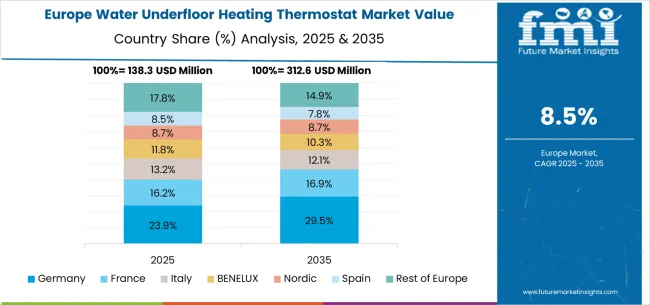
The European Water Underfloor Heating Thermostat market demonstrates mature adoption patterns with Germany leading both technology development and market scale, while countries including France, Italy, and Spain show accelerating growth through retrofit installations and new residential construction incorporating intelligent heating controls. The region benefits from stringent energy efficiency regulations under the European Green Deal that mandate smart heating technologies in new buildings and major renovations, creating sustained demand across diverse national markets with varying heating infrastructure and consumer preferences.
Northern European countries, including the Netherlands, Denmark, and Nordic nations, demonstrate high penetration rates for intelligent thermostats due to established underfloor heating infrastructure and consumer willingness to invest in energy-saving technologies, while Southern European markets show growing adoption driven by increasing energy costs and government incentives for home automation upgrades. Eastern European markets present expansion opportunities through residential construction growth and EU energy efficiency directives that promote intelligent heating controls as standard building components, creating integrated regional demand that supports technology development and competitive pricing across the European market.
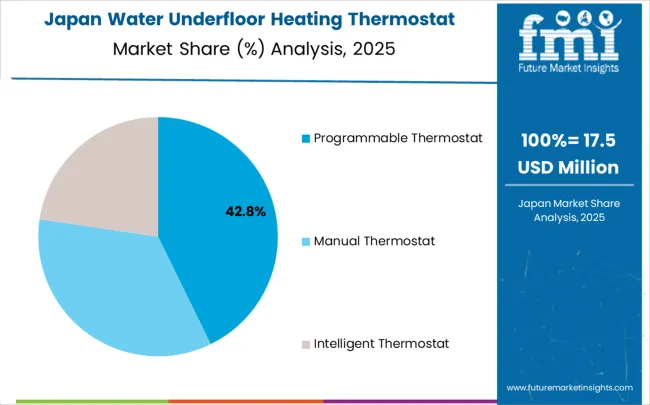
In Japan, the Water Underfloor Heating Thermostat market prioritizes Intelligent Thermostat systems, which capture the dominant share of residential and commercial installations through advanced features, including machine learning optimization and seamless integration with existing building automation infrastructure. Japanese consumers emphasize reliability, precision, and long-term operational excellence, creating demand for intelligent systems that provide predictive maintenance alerts and adaptive temperature control based on occupancy patterns and seasonal variations. Programmable Thermostat systems maintain a secondary market position primarily in cost-sensitive installations and retrofit applications where basic scheduling functionality meets consumer requirements without advanced connectivity features. Manual Thermostat systems retain minimal market presence, limited to basic installations where simplicity and low cost represent primary selection criteria.
Market Characteristics:
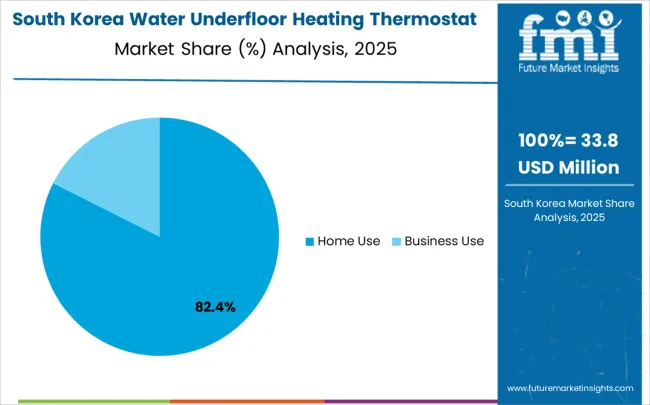
In South Korea, the market structure favors international technology companies, including Danfoss, Siemens, and Legrand, which maintain dominant positions through comprehensive product portfolios and established distribution networks supporting both residential and commercial installations. These providers offer integrated solutions combining intelligent thermostats with professional installation services and ongoing technical support that appeal to Korean consumers seeking reliable heating automation systems. Local distributors and system integrators capture moderate market share by providing localized service capabilities and competitive pricing for standard installations. At the same time, domestic manufacturers focus on specialized applications and cost-effective solutions tailored for Korean housing characteristics.
Channel Insights:
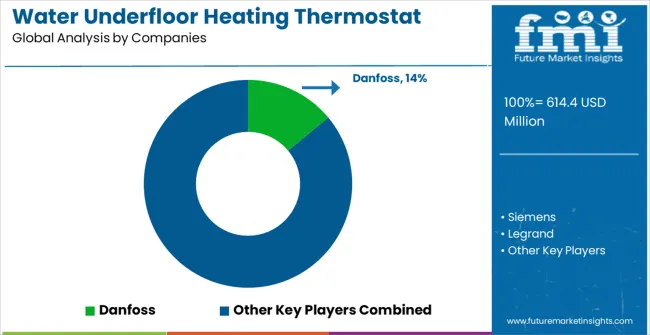
The Water Underfloor Heating Thermostat market operates with moderate concentration, featuring approximately 15-20 meaningful participants, where leading companies control roughly 40-45% of the global market share through established brand recognition and comprehensive product portfolios. Competition emphasizes technology differentiation, energy efficiency capabilities, and smart home integration features rather than price-based rivalry.
Market Leaders encompass Danfoss, Siemens, and Legrand, which maintain competitive advantages through extensive heating technology expertise, global distribution networks, and comprehensive smart home integration capabilities that create customer switching costs and support premium pricing. These companies leverage decades of HVAC industry experience and ongoing research investments to develop advanced intelligent thermostat systems with machine learning algorithms and predictive optimization features.
Technology Challengers include Saswell, ProWarm Underfloor Heating, and Warmup PLC, which compete through specialized underfloor heating focus and innovative mobile app interfaces that appeal to tech-savvy consumers seeking user-friendly smart home integration. These companies differentiate through rapid product development cycles and direct-to-consumer marketing strategies.
Regional Specialists feature companies like Heatmiser, Wunda Group, and Nu-Heat UK, which focus on specific geographic markets and application segments, including retrofit installations and premium residential projects. Market dynamics favor participants that combine reliable hardware with sophisticated software capabilities, including AI-powered learning algorithms and comprehensive smart home ecosystem compatibility. Competitive pressure intensifies as traditional HVAC companies expand into intelligent controls while technology startups challenge established players through innovative user interfaces and cost-effective solutions targeting price-sensitive market segments.
Water underfloor heating thermostats represent a rapidly expanding market segment within the broader smart home automation ecosystem, driven by the convergence of energy efficiency mandates, intelligent building technologies, and consumer demand for comfort automation. The market's trajectory from USD 614.4 million in 2025 to USD 1,508.8 million by 2035 reflects fundamental shifts in residential and commercial heating control systems, where intelligent thermostats with AI-powered optimization and IoT connectivity are replacing traditional manual controls. Successful market development requires coordinated action across government policy frameworks, industry standardization bodies, technology manufacturers, distribution channels, and financial enablers to address current barriers, including high installation costs, technical complexity, and fragmented wireless protocols, while capitalizing on energy cost reduction opportunities and smart home integration demand.
How Governments Could Accelerate Market Development and Adoption?
Building Standards & Energy Efficiency Mandates: Implement mandatory intelligent or programmable thermostat requirements in new construction and major renovation projects, similar to the UK's Future Homes Standard and EU Green Deal initiatives. Establish minimum energy efficiency performance standards for heating control systems that favor intelligent thermostats capable of delivering 20-26% energy savings through occupancy-based temperature management.
Financial Incentives & Utility Programs: Create targeted rebate programs offering 15-25% purchase incentives for intelligent thermostat installations, particularly in retrofit applications where installation complexity and costs represent primary adoption barriers. Partner with utilities to develop time-of-use pricing structures that maximize savings potential for smart heating controls capable of load shifting during peak demand periods.
Smart Infrastructure Development: Invest in broadband infrastructure and wireless connectivity standards that support reliable communication between IoT devices in both urban and rural residential markets. Fund demonstration projects in government buildings and public housing that showcase energy savings and operational benefits of intelligent heating control systems.
Regulatory Harmonization: Establish clear certification pathways for intelligent thermostats across safety, electromagnetic compatibility, and energy efficiency standards. Create unified wireless communication protocols that reduce compatibility issues between thermostat brands and existing smart home platforms, lowering consumer confusion and installation complexity.
Professional Training & Workforce Development: Support technical education programs for HVAC contractors and building automation specialists on intelligent thermostat installation, commissioning, and maintenance procedures. Develop licensing requirements that ensure proper system integration and performance optimization for maximum energy efficiency benefits.
How Industry Bodies Could Drive Market Standardization and Growth?
Technical Standards & Interoperability: Establish comprehensive performance benchmarks for intelligent thermostat learning algorithms, occupancy detection accuracy, and energy savings validation that enable reliable buyer comparisons across suppliers. Develop standardized wireless communication protocols that ensure seamless integration between thermostat brands and major smart home platforms, including Google Nest, Amazon Alexa, and Apple HomeKit.
Market Education & Professional Development: Launch technical certification programs for HVAC contractors and system integrators covering intelligent thermostat installation, wireless network configuration, and troubleshooting procedures. Create consumer awareness campaigns highlighting documented energy savings of 20-26% through intelligent temperature control and smart scheduling capabilities.
Quality Assurance & Testing Protocols: Define standardized testing methodologies for thermostat accuracy, wireless connectivity reliability, and mobile app performance that support buyer confidence and reduce warranty claims. Establish long-term durability standards that address consumer concerns about technology obsolescence and ongoing software support requirements.
Market Intelligence & Benchmarking: Provide regular market research and competitive analysis that helps manufacturers identify emerging technology trends, consumer preferences, and regional adoption patterns. Organize trade shows and technical conferences that facilitate knowledge transfer between heating system manufacturers, intelligent control developers, and building automation specialists.
How Technology Manufacturers Could Strengthen Market Infrastructure?
Advanced Hardware Development: Develop modular intelligent thermostat platforms that support both basic programmable functionality and premium AI-powered optimization features, enabling manufacturers to address diverse price segments from cost-sensitive retrofits to premium smart home installations. Integrate advanced sensors for occupancy detection, humidity monitoring, and predictive maintenance alerts that differentiate intelligent systems from basic programmable controls.
Software Platform Integration: Create comprehensive mobile applications with intuitive user interfaces that appeal to diverse demographic segments, including simplified setup procedures for non-technical users and advanced customization options for smart home enthusiasts. Develop machine learning algorithms that adapt to individual household patterns while providing transparent energy consumption reporting and savings validation.
Wireless Connectivity Solutions: Implement multiple wireless communication protocols, including Wi-Fi, Zigbee, and Z-Wave compatibility, that ensure reliable operation across diverse home network configurations. Develop mesh networking capabilities that extend wireless range and improve connection reliability in large residential and commercial installations.
Installation & Commissioning Tools: Provide professional installer mobile apps with step-by-step configuration guidance, automatic system detection, and performance validation tools that reduce installation time and ensure optimal system performance. Create diagnostic capabilities that enable remote troubleshooting and predictive maintenance to minimize service calls and improve customer satisfaction.
How Distribution Channels Could Expand Market Access?
Multi-Channel Retail Strategy: Develop integrated sales approaches combining traditional HVAC distributor networks with big-box home improvement retailers and online platforms that serve both professional contractors and DIY consumers. Create dedicated smart home product sections in retail locations with interactive displays that demonstrate the energy savings potential and mobile app functionality.
Professional Contractor Networks: Build comprehensive training and support programs for HVAC contractors that include installation certification, technical support hotlines, and marketing co-op programs that encourage contractor recommendations for intelligent thermostat upgrades. Develop contractor financing programs that enable customers to spread the cost of installation over multiple billing cycles.
Technical Support Infrastructure: Establish multilingual customer support centers with extended hours that provide installation guidance, troubleshooting assistance, and software update support. Create comprehensive online knowledge bases with video tutorials, compatibility guides, and frequently asked questions that reduce support call volume and improve customer experience.
Inventory Management & Logistics: Implement just-in-time inventory systems that ensure product availability across seasonal demand variations while minimizing carrying costs for distributors. Develop regional warehouse networks that enable same-day or next-day delivery for both professional contractors and retail customers.
How Investors and Financial Enablers Could Unlock Market Potential?
Manufacturing Scale & Automation: Finance advanced manufacturing facilities that achieve cost reductions through automated production lines and supply chain optimization, enabling intelligent thermostats to approach price parity with basic programmable units. Support vertical integration strategies that control key component costs, including sensors, wireless modules, and mobile processors.
Technology Innovation Funding: Back startups developing next-generation heating control technologies, including predictive analytics, renewable energy integration, and advanced user interface design that expand market appeal beyond traditional HVAC applications. Invest in machine learning and artificial intelligence capabilities that deliver measurable energy savings and comfort improvements.
Market Expansion Capital: Finance regional expansion programs that adapt successful business models to emerging markets with different regulatory environments, consumer preferences, and distribution channel structures. Support acquisition strategies that consolidate fragmented regional players and create scale advantages in manufacturing, marketing, and technical support.
Consumer Financing Solutions: Develop point-of-sale financing programs that enable consumers to spread intelligent thermostat purchase and installation costs over 12-36 month payment periods, reducing upfront cost barriers, particularly in retrofit applications. Create energy savings guarantee programs that provide performance assurance and reduce consumer purchase risk.
Infrastructure Development: Support smart home platform development and IoT connectivity infrastructure that creates network effects and increases intelligent thermostat value propositions through integration with security systems, lighting controls, and energy management platforms. Finance utility partnership programs that validate energy savings and develop time-of-use pricing structures that maximize consumer benefits.
| Item | Value |
|---|---|
| Quantitative Units | USD million |
| Thermostat Type | Manual Thermostat, Programmable Thermostat, Intelligent Thermostat |
| Application | Home Use, Business Use |
| Regions Covered | North America, Latin America, Europe, East Asia, South Asia & Pacific, Middle East & Africa |
| Countries Covered | China, India, Germany, Brazil, the USA, the UK, Japan, and 33+ additional countries |
| Key Companies Profiled | Danfoss, Siemens, Legrand, Saswell, ProWarm Underfloor Heating, Warmup PLC, Heatmiser, Wunda Group, Nu-Heat UK |
| Additional Attributes | Dollar sales by thermostat type and application categories, regional adoption trends across North America, Europe, and Asia-Pacific, competitive landscape with technology providers and system integrators, consumer preferences for smart home integration and energy efficiency, integration with IoT platforms and home automation systems, innovations in machine learning algorithms and predictive temperature control, and development of wireless connectivity solutions with mobile app-based management capabilities. |
How big is the water underfloor heating thermostat market in 2025? The global water underfloor heating thermostat market is valued at USD 614.4 million in 2025.
What will be the size of the water underfloor heating thermostat market in 2035? The size of the water underfloor heating thermostat market is projected to reach USD 1,508.8 million by 2035.
How much will the water underfloor heating thermostat market grow between 2025 and 2035? The water underfloor heating thermostat market is expected to grow at a 9.4% CAGR between 2025 and 2035.
What are the key thermostat type segments in the water underfloor heating thermostat market? The key thermostat type segments in the water underfloor heating thermostat market are Manual Thermostat, Programmable Thermostat, and Intelligent Thermostat.
Which application segment is expected to contribute a significant share in the water underfloor heating thermostat market in 2025? In terms of application, the Home Use segment is set to command the dominant share in the water underfloor heating thermostat market in 2025.
The global water underfloor heating thermostat market is estimated to be valued at USD 614.4 million in 2025.
The market size for the water underfloor heating thermostat market is projected to reach USD 1,508.8 million by 2035.
The water underfloor heating thermostat market is expected to grow at a 9.4% CAGR between 2025 and 2035.
The key product types in water underfloor heating thermostat market are programmable thermostat, manual thermostat and intelligent thermostat.
In terms of application, home use segment to command 80.0% share in the water underfloor heating thermostat market in 2025.






Our Research Products

The "Full Research Suite" delivers actionable market intel, deep dives on markets or technologies, so clients act faster, cut risk, and unlock growth.

The Leaderboard benchmarks and ranks top vendors, classifying them as Established Leaders, Leading Challengers, or Disruptors & Challengers.

Locates where complements amplify value and substitutes erode it, forecasting net impact by horizon

We deliver granular, decision-grade intel: market sizing, 5-year forecasts, pricing, adoption, usage, revenue, and operational KPIs—plus competitor tracking, regulation, and value chains—across 60 countries broadly.

Spot the shifts before they hit your P&L. We track inflection points, adoption curves, pricing moves, and ecosystem plays to show where demand is heading, why it is changing, and what to do next across high-growth markets and disruptive tech

Real-time reads of user behavior. We track shifting priorities, perceptions of today’s and next-gen services, and provider experience, then pace how fast tech moves from trial to adoption, blending buyer, consumer, and channel inputs with social signals (#WhySwitch, #UX).

Partner with our analyst team to build a custom report designed around your business priorities. From analysing market trends to assessing competitors or crafting bespoke datasets, we tailor insights to your needs.
Supplier Intelligence
Discovery & Profiling
Capacity & Footprint
Performance & Risk
Compliance & Governance
Commercial Readiness
Who Supplies Whom
Scorecards & Shortlists
Playbooks & Docs
Category Intelligence
Definition & Scope
Demand & Use Cases
Cost Drivers
Market Structure
Supply Chain Map
Trade & Policy
Operating Norms
Deliverables
Buyer Intelligence
Account Basics
Spend & Scope
Procurement Model
Vendor Requirements
Terms & Policies
Entry Strategy
Pain Points & Triggers
Outputs
Pricing Analysis
Benchmarks
Trends
Should-Cost
Indexation
Landed Cost
Commercial Terms
Deliverables
Brand Analysis
Positioning & Value Prop
Share & Presence
Customer Evidence
Go-to-Market
Digital & Reputation
Compliance & Trust
KPIs & Gaps
Outputs
Full Research Suite comprises of:
Market outlook & trends analysis
Interviews & case studies
Strategic recommendations
Vendor profiles & capabilities analysis
5-year forecasts
8 regions and 60+ country-level data splits
Market segment data splits
12 months of continuous data updates
DELIVERED AS:
PDF EXCEL ONLINE
Water Vapor Permeability Analyzers Market Size and Share Forecast Outlook 2025 to 2035
Water and Waste Water Treatment Chemical Market Size and Share Forecast Outlook 2025 to 2035
Water-cooled Walk-in Temperature & Humidity Chamber Market Size and Share Forecast Outlook 2025 to 2035
Waterless Bathing Solution Market Size and Share Forecast Outlook 2025 to 2035
Water Treatment System Market Size and Share Forecast Outlook 2025 to 2035
Waterborne UV Curable Resin Market Size and Share Forecast Outlook 2025 to 2035
Water Treatment Chemical Market Size and Share Forecast Outlook 2025 to 2035
Water Adventure Tourism Market Forecast and Outlook 2025 to 2035
Water Packaging Market Forecast and Outlook 2025 to 2035
Water Soluble Bag Market Size and Share Forecast Outlook 2025 to 2035
Water Leak Sensors Market Size and Share Forecast Outlook 2025 to 2035
Water-soluble Packaging Market Size and Share Forecast Outlook 2025 to 2035
Water Leak Detection System for Server Rooms and Data Centers Market Size and Share Forecast Outlook 2025 to 2035
Water and Wastewater Treatment Equipment Market Size and Share Forecast Outlook 2025 to 2035
Water Treatment Market Size and Share Forecast Outlook 2025 to 2035
Water Activity Meter Market Size and Share Forecast Outlook 2025 to 2035
Water Leakage Tester Market Size and Share Forecast Outlook 2025 to 2035
Waterstops Market Size and Share Forecast Outlook 2025 to 2035
Water-miscible Metalworking Oil Market Size and Share Forecast Outlook 2025 to 2035
Waterborne Polyurethane Dispersions Market Size and Share Forecast Outlook 2025 to 2035

Thank you!
You will receive an email from our Business Development Manager. Please be sure to check your SPAM/JUNK folder too.
Chat With
MaRIA